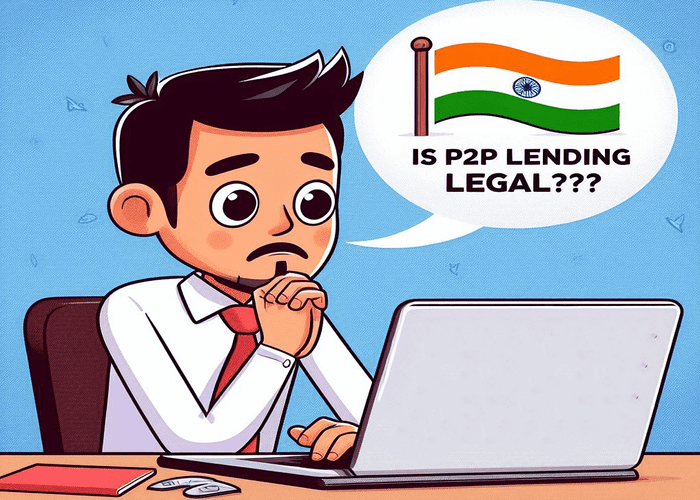Discover if P2P lending is legal in India and understand the regulatory framework governing this alternative investment avenue. Learn how P2P lending platforms operate within legal boundaries, providing investors and borrowers with a secure and regulated environment for financial transactions.
India has always been a ground for emerging businesses, with new startups sprouting up in every lane of its bustling cities. Whether bootstrapped with personal savings or kick-started with investor funds, the entrepreneurial journey of every man or woman begins with a vision. Yet, for many small-scale vendors and aspiring entrepreneurs, gathering sufficient capital remains a daunting hurdle. Or for the people who are in urgency to apply for a loan.
This article will guide you a bit through the status and the impact of P2P if you can start investing in India. while with innovation often comes a shroud of uncertainty. Is P2P lending legal in India? The answer is a resounding yes, but with a crucial caveat: it’s a legal avenue strictly regulated by the Reserve Bank of India (RBI).
The Framework of RBI for P2P:
The Reserve Bank of India (RBI) introduced a regulatory framework for Peer-to-Peer (P2P) lending platforms in October 2017. This framework essentially classifies P2P lending platforms as a special type of Non-Banking Financial Company (NBFC) called NBFC-P2P
- Registration Requirement: P2P platforms must be registered with the RBI to function legally. This ensures that the platforms meet baseline regulatory standards.
- Consumer Protection: The RBI guidelines mandate P2P platforms to implement fair lending practices and transparent terms of service for both lenders and borrowers. This helps protect users from unfair loan terms or hidden fees.
- Risk Management: RBI regulations require P2P platforms to have robust risk management practices in place. This includes measures to assess borrower creditworthiness, manage potential defaults, and safeguard user data.
The RBI’s framework aims to establish a balanced approach. While P2P platforms are subject to regulations, they are not bound by the same stringent norms as traditional NBFCs. This allows them to retain some flexibility in their business models. Overall, the regulations aim to promote the responsible growth of P2P lending in India while ensuring a secure environment for lenders and borrowers.
Regulations that Govern P2P:
P2P platforms can’t operate without a formal green light from the RBI. This ensures a baseline level of legitimacy and adherence to regulations. The RBI doesn’t just register platforms; it sets specific operational and financial guidelines they must follow. These rules are designed to create a secure environment for both lenders and borrowers. The RBI doesn’t just register platforms; it sets specific operational and financial guidelines they must follow. These rules are designed to create a secure environment for both lenders and borrowers.
The regulations go beyond a simple registration process. They establish a framework for responsible lending practices. This includes measures to ensure transparency in terms of service, fair treatment of borrowers, and robust risk management practices to safeguard user funds.
The Impact on Borrowers and Lenders:
Borrowers:
- Easier Access to Credit: P2P lending platforms can be more flexible than traditional banks when assessing creditworthiness. This can be helpful for borrowers with limited credit history or those who may not qualify for a bank loan.
- Potentially Lower Interest Rates: Borrowers with good creditworthiness may be able to secure loans on P2P platforms at lower interest rates compared to traditional lenders.
Lenders:
- Higher Potential Returns: P2P lending can offer investors the opportunity to earn higher returns on their money compared to traditional savings accounts or fixed deposits.
- Investment Diversification: P2P platforms allow lenders to spread their investments across multiple loans, potentially mitigating risk.
Platforms:
- Reduced Costs: The online nature of P2P lending allows platforms to operate with lower overhead costs compared to traditional financial institutions. This can translate into lower fees for borrowers and lenders.
- Streamlined Process: P2P platforms leverage technology to streamline the loan application and approval process, benefiting both borrowers and lenders.
Is there a future in P2P lending and borrowing in India?
Industry experts predict significant growth for the P2P lending market in India, with projections reaching $10.5 billion by 2026. This indicates a growing acceptance and integration of P2P lending into the financial ecosystem.
P2P platforms empower individuals to participate directly in lending and borrowing, bypassing traditional gatekeepers and fostering a more democratic approach to finance.
As P2P lending grows, it has the potential to nurture a community of lenders and borrowers who build trust through responsible lending practices and transparent interactions.
Overall, P2P lending in India is poised to become a significant player in the financial services sector, offering a more accessible, efficient, and potentially rewarding alternative for both borrowers and lenders.




